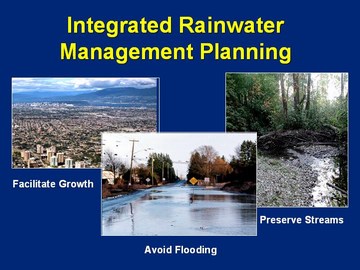Template for Integrated Stormwater Management Planning 2005
Over the past decade, the term Integrated Stormwater Management Planning (ISMP) has gained widespread acceptance by local governments and the environmental agencies in British Columbia to describe a comprehensive, ecosystem-based approach to rainwater management. Local government typically has control over rainwater runoff in residential, commercial and industrial land uses. Thus, the purpose of an ISMP is to provide a clear picture of how to be proactive in applying land use planning tools to protect property from flooding, and protect aquatic habitat from erosion and sedimentation. Use of the term ISMP is unique to British Columbia. The City of Kelowna first used the term in 1998 to make a clear distinction between ‘suburban watershed management' and the Province's existing ‘integrated watershed management' process for natural resource management in wilderness watersheds. For context on the history and evolution of ISMPs in British Columbia, download Chapter 1 from Stormwater Planning: A Guidebook for British Columbia at http://www.waterbucket.ca/rm/sites/wbcrm/documents/media/16.pdf There has been a change in thinking among drainage practitioners, and the technical language is in transition. This change has seen the single function view of traditional 'stormwater management' give way to the integrated and comprehensive perspective that is captured by the term 'rainwater management'. Stormwater suggests there is a problem, whereas rainwater is a resource. GREATER VANCOUVER REGIONAL DISTRICT The Greater Vancouver Regional District (GVRD) and its municipalities have responsibility under the federal Fisheries Act to protect fish and fish habitat from negative impacts associated with storm and rainwater discharges to the environment. Of concern are potential runoff quantity and water quality changes to the region's many urban and rural salmon and trout streams. The GVRD, its municipalities, and provincial and federal environmental agencies in 2002 formed the Stormwater Interagency Liaison Group (SILG) to facilitate the co-ordination and sharing of common research related to rainwater and stormwater management (the legal framework used was the Provincial Waste Management Act, which includes the management of stormwater). One of the primary results of this co-ordinated approach was the creation in 2002 of a template for Integrated Stormwater Management Plans (ISMPs), which are watershed- specific, flexible and adaptive strategies. These plans integrate water management issues including watershed health, land use planning, engineering, community values and climate change and variability. Although climate change is not the primary driver in the development of these plans (expanding urbanization and intensive agriculture are), climate change has been integrated into the ISMP process and other approaches directed at managing the health of streams in the region. In developing the ISMP process the GVRD and its members created an inclusive and comprehensive tool for managing complex risk-management issues that improves the region's capacity to deal with environmental risk, including the potential risks of climate change and variation. The ISMP goal is to develop effective rainwater managment plans that will result in no net loss to environmental quality and protect communities from localized flooding. The process actively seeks and uses input from various stakeholder groups within each watershed, and brings together planning, engineering, ecology, and flood and erosion protection within an adaptive management methodology. ISMPs will be developed throughout the GVRD in the order of watershed priority. Within each ISMP process, an advisory group, including representatives from the development, agricultural, and environmental sectors, contributes historical knowledge of the watershed and helps to assess the benefits of the ISMP over time. The general public is involved in evaluating alternative management scenarios and reviewing the plan's success. This roundtable approach relies on a combination of knowledge on land use, water resources, and engineering from governments, local residents and key experts. A widely supported set of final adaptive management rules will allow landowners and developers to make longterm investment decisions with confidence, provide government agencies with regulatory certainty, and ensure that the investments of municipal governments lead to continuous improvements in stormwater management. Member municipalities have agreed to implement ISMPs in all urban watersheds by 2014. When fully implemented, the adaptive management approach of the ISMPs are intended to address potential drainage, erosion, and flooding concerns, protect riparian and aquatic habitat, and remediate existing excess rainwater runoff. ISMPs will be regularly reviewed and updated. The Template for Integrated Stormwater Management Planning 2005 provides a standardized process that includes all of the key components for rainwater and stormwater management. These are categorized in terms of three disciplines – engineering, planning and environmental. A municipality can decide which components are applicable, and can establish the level of effort required based on risk and local conditions. Not all of the components may be relevant for a given watershed or drainage catchment. The ISMP Template is nested within Chapter 9 of Stormwater Planning: A Guidebook for British Columbia Posted August 2006
View publication
Integrated Rainwater Mgmt Planning
Author Kerr Wood Leidal Associates Ltd
Publisher Greater Vancouver Regional District


